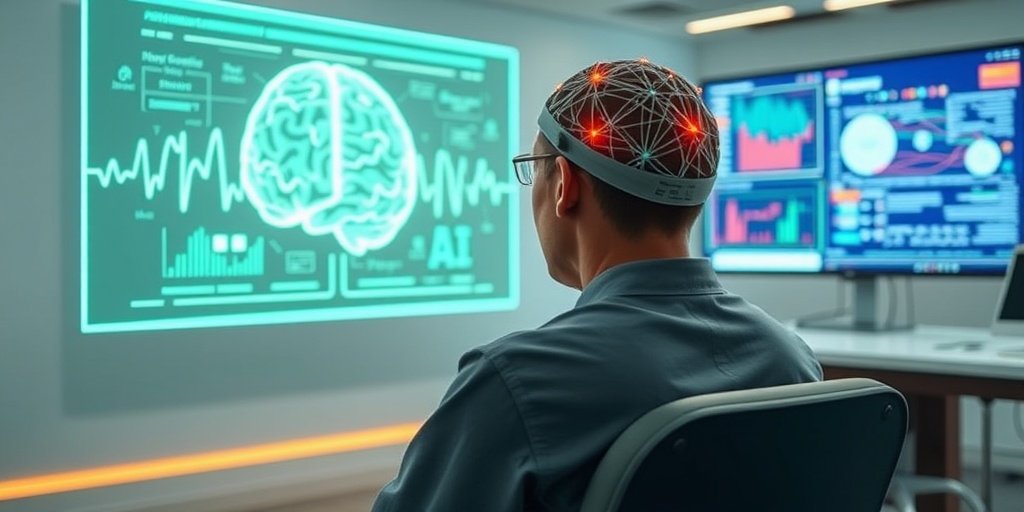⚡ Quick Summary
This study introduces EEGEncoder, a transformer-based deep learning framework designed to enhance motor imagery classification in brain-computer interfaces (BCIs). The model achieved an impressive average accuracy of 86.46% for subject-dependent tasks, showcasing its potential to significantly improve device control for individuals with motor impairments.
🔍 Key Details
- 📊 Dataset: BCI Competition IV-2a
- 🧩 Features used: Electroencephalographic (EEG) signals
- ⚙️ Technology: Modified transformers and Temporal Convolutional Networks (TCNs)
- 🏆 Performance: Average accuracy of 86.46% (subject-dependent), 74.48% (subject-independent)
🔑 Key Takeaways
- 🧠 EEGEncoder utilizes advanced deep learning techniques to improve BCI performance.
- 💡 The Dual-Stream Temporal-Spatial Block (DSTS) architecture captures both temporal and spatial features effectively.
- 📈 The model’s accuracy represents a significant advancement over traditional machine learning methods.
- 🔍 Subject-independent accuracy of 74.48% indicates robustness in diverse applications.
- 🤖 Multiple parallel structures enhance the model’s overall performance.
- 🌍 This research could lead to better assistive technologies for individuals with motor impairments.
- 📅 Published in 2025 in the journal Sci Rep.

📚 Background
Brain-computer interfaces (BCIs) represent a groundbreaking approach to assist individuals with motor impairments by allowing direct control of devices through electroencephalographic signals. However, traditional machine learning methods for classifying motor imagery often struggle with manual feature extraction and are vulnerable to noise, limiting their effectiveness. The need for more sophisticated models has become increasingly apparent as the demand for reliable BCI technology grows.
🗒️ Study
The study aimed to address the limitations of existing BCI technologies by introducing EEGEncoder, a novel framework that integrates modified transformers and Temporal Convolutional Networks (TCNs). The researchers developed the Dual-Stream Temporal-Spatial Block (DSTS) architecture to effectively capture both temporal and spatial features from EEG signals, thereby enhancing the accuracy of motor imagery classification tasks.
📈 Results
When evaluated on the BCI Competition IV-2a dataset, the EEGEncoder model achieved an average accuracy of 86.46% for subject-dependent tasks and 74.48% for subject-independent tasks. These results highlight the model’s capability to outperform traditional methods, demonstrating its potential for practical applications in assistive technologies.
🌍 Impact and Implications
The advancements presented in this study could significantly impact the field of assistive technology. By improving the accuracy of motor imagery classification, EEGEncoder has the potential to enhance the quality of life for individuals with motor impairments, enabling more effective control of devices and fostering greater independence. This research paves the way for future innovations in brain-computer interfaces and their applications in various domains.
🔮 Conclusion
The introduction of EEGEncoder marks a significant step forward in the development of brain-computer interfaces. By leveraging advanced deep learning techniques, this study demonstrates the potential for improved motor imagery classification, which could lead to transformative changes in assistive technologies. Continued research in this area is essential to unlock the full capabilities of BCIs and enhance the lives of those with motor impairments.
💬 Your comments
What are your thoughts on the advancements in brain-computer interfaces? How do you see technologies like EEGEncoder shaping the future of assistive devices? Let’s engage in a discussion! 💬 Please share your insights in the comments below or connect with us on social media:
Advancing BCI with a transformer-based model for motor imagery classification.
Abstract
Brain-computer interfaces (BCIs) harness electroencephalographic signals for direct neural control of devices, offering significant benefits for individuals with motor impairments. Traditional machine learning methods for EEG-based motor imagery (MI) classification encounter challenges such as manual feature extraction and susceptibility to noise. This paper introduces EEGEncoder, a deep learning framework that employs modified transformers and Temporal Convolutional Networks (TCNs) to surmount these limitations. We propose a novel fusion architecture, named Dual-Stream Temporal-Spatial Block (DSTS), to capture temporal and spatial features, improving the accuracy of Motor Imagery classification task. Additionally, we use multiple parallel structures to enhance the model’s performance. When tested on the BCI Competition IV-2a dataset, our proposed model achieved an average accuracy of 86.46% for subject dependent and average 74.48% for subject independent.
Author: [‘Liao W’, ‘Liu H’, ‘Wang W’]
Journal: Sci Rep
Citation: Liao W, et al. Advancing BCI with a transformer-based model for motor imagery classification. Advancing BCI with a transformer-based model for motor imagery classification. 2025; 15:23380. doi: 10.1038/s41598-025-06364-4